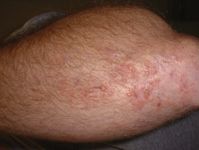- General Dermatology
- Eczema
- Chronic Hand Eczema
- Alopecia
- Aesthetics
- Vitiligo
- COVID-19
- Actinic Keratosis
- Precision Medicine and Biologics
- Rare Disease
- Wound Care
- Rosacea
- Psoriasis
- Psoriatic Arthritis
- Atopic Dermatitis
- Melasma
- NP and PA
- Skin Cancer
- Hidradenitis Suppurativa
- Drug Watch
- Pigmentary Disorders
- Acne
- Pediatric Dermatology
- Practice Management
- Prurigo Nodularis
Article
The big picture: Knowing signs of systemic disease can help avert complications
Gastrointestinal (GI) symptoms may sometimes be related to dermatologic conditions. Recognizing the connection can prevent unnecessary complications, an expert says.

Key Points

"Identifying the skin signs of systemic disease can sometimes help prevent the onset of a major systemic complication," says Dr. Brodell, professor of internal medicine, dermatology section, and clinical professor of dermatopathology at Northeastern Ohio Universities Colleges of Medicine and Pharmacy, Rootstown, Ohio, and associate clinical professor of dermatology, Case Western Reserve University School of Medicine, Cleveland, Ohio.
Dr. Brodell describes two dermatologic cases that involved GI symptoms.
In the first case, a diagnosis of dermatitis herpetiformis not only allowed for treatment that relieved the patient of severe pruritus, but also may have prevented the development of bowel lymphoma.

"A presumptive diagnosis of dermatitis herpetiformis was made, and a skin biopsy confirmed the diagnosis by demonstrating microabscesses in the papillary dermis associated with granular IgA deposition on direct immunofluorescence," he says.
The patient's pruritus and rashing responded "immediately and miraculously to treatment with Dapsone (diaminodiphenyl sulfone, Jacobus)," but Dr. Brodell knew there was more to the equation.
Noting that dermatitis herpetiformis is caused by an allergy to gluten - a protein found in wheat and some grains - Dr. Brodell also recommended a gluten-free diet.
"This is a very difficult diet to follow, but patients who substitute rice-based breads and cakes, and work hard to eliminate many pre-prepared foods that contain gluten, can have relief of the gastrointestinal symptoms," he says.
As the patient became accustomed to following a gluten-free diet, the Dapsone dose was reduced and eventually discontinued. The patient now takes Dapsone for several days at a time when he flares, which usually occurs when he has a dietary lapse.
Physicians should keep in mind that dermatitis herpetiformis is directly linked to gluten sensitivity, and putting such patients on a gluten-free diet can be key to preventing further complications, Dr. Brodell tells Dermatology Times.
"Dermatitis herpetiformis is associated with a gluten-sensitive enteropathy, and some patients may have diarrhea or other GI symptoms," he says.
"Most importantly, if the diagnosis is not made and the patient continues to eat gluten, the incessant stimulation of the immune system in the bowel can lead to bowel lymphoma.
"Following a strict gluten-free diet may minimize the potential for developing this most serious complication of dermatitis herpetiformis," Dr. Brodell says.
Another case study
Dr. Brodell describes another case with a potential dermatologic-gastrointestinal link: A 4-month-old infant presented with 25 brownish-red papules of 2 mm to 4 mm on the trunk and extremities.
The infant's mother indicated that the lesions would hive when rubbed, and one lesion had blistered. Dr. Brodell noted that rubbing a typical lesion on the patient's left arm resulted in a plaque-like hive, a Darier's sign.
In addition to the dermatologic symptoms, the infant's mother noted that the child had a major problem with diarrhea and colic, which had not responded to several changes of formula.
Dr. Brodell performed a biopsy of one of the papules, and the results were clear.
"A biopsy of a papule showed mast cells comprising the bulk of the inflammatory cells in the lesion," he says. "The patient clearly has urticaria pigmentosa."
He says that the serum tryptase level is a useful diagnostic marker for urticaria pigmentosa in reflecting the burden of mast cells.
"Elevated levels suggest systemic mastocytosis," Dr. Brodell says.
The patient's cutaneous lesions were treated with clobetasol 0.05 percent cream twice a day for two weeks, and then once a day for two weeks.
The patient's mother was also given a list of topical and systemic drugs that can induce mast cell degranulation and should, therefore, be avoided.
Dr. Brodell says it is not clear whether the GI symptoms could represent a systemic complication of urticaria pigmentosa.
"It is important to consult with the pediatrician, because treatment with antihistamines and perhaps mast cell stabilizers (disodium cromolyn) may help the GI symptoms where other efforts have failed," Dr. Brodell says.





